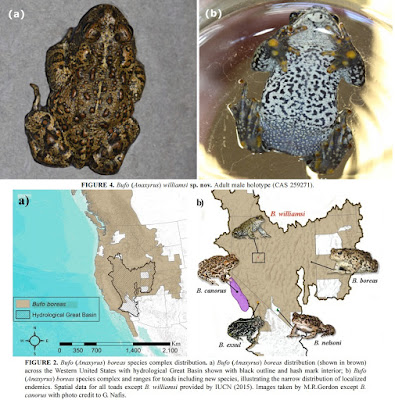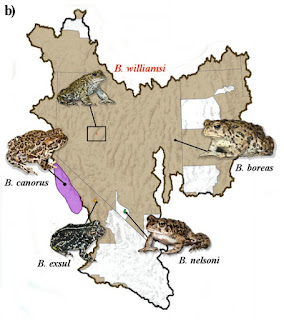Abstract
We describe a new species of toad from the Great Basin region of northern Nevada belonging to the Bufo (Anaxyrus) boreas species complex. This cryptic species was detected through genetic analyses of toad populations sampled throughout the Great Basin and the morphological evidence was quantified through extensive sampling of live toads within the region. The new species has the smallest body size in the species complex, and can be further diagnosed from other species in the complex by its large tibial glands and unique coloration. The known distribution of the new species is restricted to an area less than 6 km2 in Dixie Valley, Churchill Co., Nevada. The Great Basin is an arid region where aquatic resources are both rare and widely scattered, making habitat suitable for anuran populations highly vulnerable to anthropogenic change. The habitat occupied by this newly described species is threatened by the incipient installation of geothermal and solar power development projects that require the water that defines its habitat.
Keywords: Amphibia, Bufo (Anaxyrus) williamsi sp. nov., Dixie Valley Toad, Western Toad, Bufo(Anaxyrus) boreas species complex, cryptic species, morphology, new species, conservation, geothermal
Bufo (Anaxyrus) williamsi sp. nov.
Dixie Valley Toad
Diagnosis. Bufo (Anaxyrus) williamsi is distinguishable from B. boreas by a combination of diagnostic morphological characters (Fig. 4; Table 1, Table 2), genetic evidence (Fig.3, Fig. 6), and localized distribution (Fig. 2b). Bufo (Anaxyrus) williamsi is distinct from B. boreas by: a small adult body size (SVL is more than 2.5 cm smaller than B. boreas; Table 1); significantly, but modestly, larger, closely-set eyes, and smaller head (Table 2); statistically and perceptibly larger tympanum, and shorter hind limbs; conspicuously large and elevated tibial glands; and distinctive color pattern (Fig. 4a, Fig. 4b).
Etymology. The specific epithet is in tribute to Robert Williams, former Field Supervisor of the U.S. Fish and
Wildlife, whose Herculean efforts on behalf of the fauna of Nevada and California were critically important in
discovering additional biodiversity of anurans in the Great Basin, and in focusing on the needs to provide
protection to the rare and imperiled fauna, and the ecosystems upon which they depend, in Nevada and California.
The Dixie Valley toad would not have been discovered without the efforts of this courageous public servant.
Distribution. Bufo (Anaxyrus) williamsi is found only within wetlands of limited extent fed from artesian
springs on the western edge of the Dixie Valley Playa, east of the Stillwater Range in Dixie Valley, NV (Fig. 2b).
Natural history. Bufo (Anaxyrus) williamsi is restricted to the spring fed-wetland habitat along the western
edge of the Dixie Valley playa. Similar to other toads in the B. boreas complex (except perhaps B. exsul, which is
more aquatic), the terrestrial B. williamsi is typically nocturnal, emerging at dusk, and can be found in moist
vegetation or in very still, shallow water with very little vegetation canopy. Dixie Valley experiences extreme
temperature fluctuations between day and night temperatures, as well as season-to-season extremes, characteristic
of cold desert ecosystems.
Michelle R. Gordon, Eric T. Simandle and C. R. Tracy. 2017. A Diamond in the Rough Desert Shrublands of the Great Basin in the Western United States: A New Cryptic Toad Species (Amphibia: Bufonidae: Bufo (Anaxyrus)) discovered in Northern Nevada.
Zootaxa. 4290(1); 123–139. DOI: 10.11646/zootaxa.4290.1.7
Zootaxa. 4290(1); 123–139. DOI: 10.11646/zootaxa.4290.1.7




